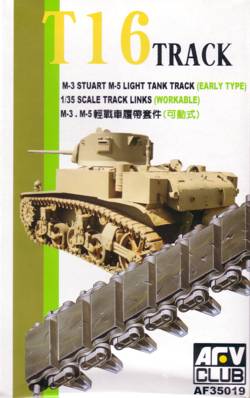|
T16
Track (Early Type) for M3 Stuart M5 Light Tank
|
 |
|
The advent of good, inexpensive and easy-to-assemble styrene after-market track sets has been a real boon for most U.S. armor fans. For too long, most of us were stuck with either whatever came in the Tamiya kits, most of which were over 20 years old, or having to purchase expensive and difficult to assemble Model Kasten styrene replacement sets. The former were downright awful, with the M3 medium tanks and M3, M5A1, and M8 kits all suffering from having the very noticeable end connectors attached to the centers of the track links, and not the track link ends. The latter required up to twelve hours to assemble, usually had sink holes in the track pad faces, and were very fiddly to deal with. When AFV Club released its working sets for the M88 and M48/M60, as well as the M-1 Abrams, a new standard in modeling was achieved. The tracks were semi- workable, with end connectors which simply slid onto the track links, permitting them to flex, and which also permitted not only accurate depiction of the tracks, but also provided the modeler with the ability to easily paint them off the model and then install them. AMPS members agreed these were among the best ideas in a long time, and awarded them the Gold Medal for Best Injection Molded Accessory for 1994. Along with their companion late model "three bar cleat" all steel cast T36E6 track, AFV Club covers nearly all of the primary options for the M3 series light tanks, the M5 series light tanks, the M8 75mm HMC, and the derivative vehicles like the M5 13-Ton High Speed Tractor. The T16 tracks are the reversible rubber pad type such as those which were poorly represented in the Tamiya M3, M5A1, and M8 kits. Each link consists of the now famous AFV Club link with four long styrene pins and two end connectors with bushings. The T16 tracks will necessitate a bit of cleanup, with slight ejector pin marks on one side of each pad. An additional step is required to prepare the model to take these tracks, namely burring off the rings which Tamiya placed inside the drive wheels on all three models; this is so the correct length guide teeth can fit down over the driver teeth into position. There is only one catch: the tracks have to be assembled one link at a time. With the other M48 series tank tracks, the end connectors were set up on the sprues so that a number of links could be assembled at one time in a near jig-like arrangement. Those sets only took me an average of three hours to clean up and assemble for painting. These tracks will have to be done carefully, one link at a time, with care taken to trap the pins of the next link when assembling the connectors to the previous one. This is a bit tedious, but the results are worth it, and the tracks are much better overall than the only other option—heat-bent resin. Overall, these tracks correct one of the most egregious flaws of the M3 and M5 series models from Tamiya. -Cookie Sewell |
 |
 |
 |
 |
 |
 |
 |
 |
 |
 |
 |
 |
|
 AFV
Club
AFV
Club